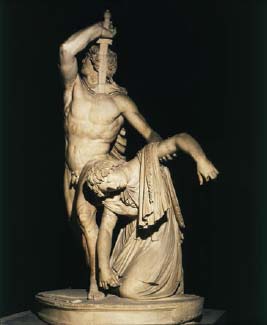Art of the Ancient World, C. 5000 B.c.e.–400 C.E.Ancient Greek Art |
What is the Pergamese style? |
During the fourth century B.C.E., Alexander the Great marched Greek culture over nearly half the globe, and when he died suddenly in 323 B.C.E., his vast empire fell into fragmented city-states and small kingdoms. One such kingdom, Pergamon, was located in present-day Turkey and became a leading city for art during the Hellenistic period. Art from Pergamon is known for being emotionally expressive and emphasizes acts of heroism. An example of the Pergamene style is a sculpture known as Gallic Chieftain Killing His Wife and Himself. The sculpture depicts a military victory over the Celtic Gauls in France. It was originally in bronze, and now exists only in Roman copies. The work romanticizes the death of the leader of the Gauls who commits suicide rather than surrender to the Pergamese. His wife, who he has already stabbed to death, falls limp in his left arm as he turns away and plunges a sword into his own chest. This dramatic sculpture attempts to evoke a feeling of sympathy and admiration for the fallen chief, and is a powerful example of the expressive Pergamese style.

Art from the Greek Hellenistic period is known for is heightened drama and realism. This Hellenistic sculpture depicts a Gallic chief as he kills his wife and himself after a loss in battle. The work evokes a mixture of pity and respect from the viewer. (Art courtesy The Art Archive / Museo Nazionale Terme Rome / Gianni Dagli Orti.)
